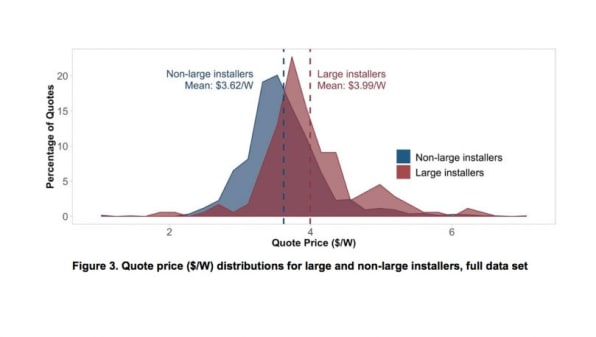If you’re thinking about getting solar panels for your roof, here’s two pieces of advice, free of charge. One, shop around. And, two, don’t be afraid to consider smaller, local installers. Bigger national brands may have the marketing muscle and marketplace presence, but they could be more expensive.
Using data from EnergySage, an Expedia-like site where installers quote for customer business, the National Renewable Energy Laboratory (NREL) analyzed the relationship between installer size and prices. It found that large installers (which do more than 1,000 jobs a year) were on average 10% more expensive than “non-large” ones (performing fewer than 1,000 jobs a year). The difference, on average, was $ 0.33 per watt, which for a standard 6 kilowatt home system could mean paying almost $ 2,000 more on the total installation price, the report finds.

The results are intriguing because you’d normally expect larger companies, with their economies of scale, to offer better prices. Generally, Albertsons or Safeway have better deals than your neighborhood grocer because they buy in bulk. But then it’s possible that household solar isn’t yet a well-functioning market–with transparent prices and companies that compete vigorously for your business.
The report offers three reasons why bigger companies bid higher on EnergySage (and presumably in the wider solar market). First, and most likely, they have higher “customer acquisition” costs. In other words, they spend more on marketing and advertising than local installers that are more likely to rely on word of mouth to win business.
“It’s possible there are some diseconomies of scale and that larger companies have higher costs that would extend to them bidding higher prices,” report coauthor Eric O’Shaughnessy tells Fast Company. “As you reach national scale, you have to spend more money per customer than when you’re operating more locally.”
In the past, companies like Sunrun, SolarCity, and Vivint have reported spending 70 cents or more per installed watt on sales and marketing. For a 6 KW system, that means a whopping $ 4,200 outlay just to find a customer to buy it.
There are other (less powerful) explanations, says O’Shaughnessy. One is that larger installers have more market power, insulating themselves from price competition. In 2015, the top 10% of companies by size had 90% of the market. When customers seek out relatively few quotes, bigger companies can sustainably offer higher prices and not be undercut. Also, smaller firms might be forced to offer lower prices just to build up their businesses.
Moreover, says O’Shaughnessy, it’s possible that solar installers offer slightly different packages. Though the study compared bids for the same system size, it didn’t consider if the companies offered different warranty lengths or module replacement guarantees. In other words, there could be non-monetary reasons why customers accept higher prices even though lower prices are available. The research looked only at prices, not at other factors weighing on customer choices.
Either way, though, the research bolsters the case for more transparency in the solar market. The report says competition encourages installers to lower their bids. “Installers that provide quotes through EnergySage know that customers have access to other competitive quotes, reducing the probability that an installer could successfully win a high-price bid,” it says.
Operating in 34 states and Washington, D.C., EnergySage offers four to seven quotes for your zip code. It only includes installers offering transparent pricing and terms, and those that have been in business for at least three years. You plug in your address, locate your property from an aerial photo, and upload your electricity bill to see what savings you can make from generating your own power. The site then sends your profile to its dealer network, which returns quotes. (SolarCity, the largest U.S. installer, chooses not to bid on the site, though Energy Sage CEO and founder Vikram Aggarwal says its prices would definitely put it on the more expensive side of NREL’s pricing graph).
In an interview, Aggarwal compares EnergySage to Kayak or other travel-comparisons sites. He argues you would never buy a flight these days without checking out the prices of several airlines, and, indeed, it doesn’t make sense to do that with solar. “Marketplaces have transformed other industries. You would have a difficult time deciding whether to fly or not without a comparison site,” he says.
Comparison shopping tends to drive down every installer’s prices. “All customers could benefit from obtaining more quotes,” adds O’Shaughnessy. “Many customers will choose to work with a bigger company anyway. But, regardless, you may be able to save money by approaching smaller companies, even if you don’t ultimately adopt them. Shopping around has its own value.”
(41)